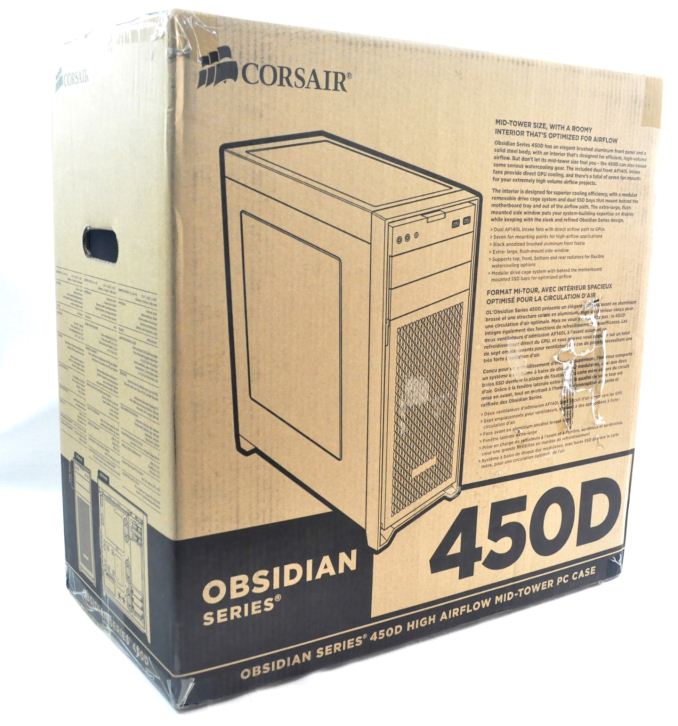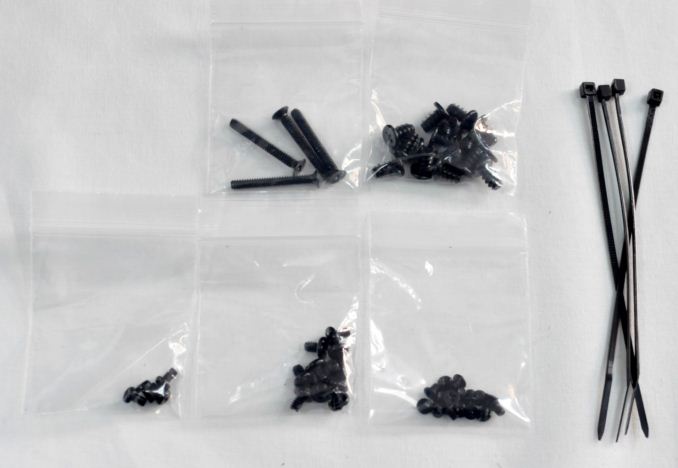Corsair Obsidian 450D Case Review
by E. Fylladitakis on April 4, 2014 6:00 AM EST- Posted in
- Cases/Cooling/PSUs
- Corsair
- mid-tower
- Case

Corsair Obsidian 450D: Introduction and Packaging
Corsair is a company that hardly requires an introduction; almost every PC user has heard of their name and a large number own at least one of their products. More advanced users know that Corsair is one of the oldest companies that's still around. The company was established in 1994 as a cache module manufacturer but their focus changed to DRAM modules a few years later. Corsair began a very aggressive diversification scheme over the past decade, which turned the DRAM manufacturer into a giant that markets several dozen technology-related products, their four series of cases being among the most popular of them.
Depite having over a dozen designs available, Corsair is continuously releasing new cases to enrich their product ranks. It's only been a few months since the release of the Obsidian 250D, a cubic Mini-ITX case, and today yet another product joins the ranks of the Obsidian series. In this review, we'll look at Corsair's newest mid-tower case, the Obsidian 450D, a case designed to bridge the gap between the Micro-ATX Obsidian 350D and the towering Obsidian 750D.
| Corsair Obsidian 450D Specifications | ||
| Motherboard Form Factor | ATX, Micro-ATX, Mini-ITX | |
| Drive Bays | External | 2 x 5.25" |
| Internal |
3 x 2.5"/3.5" (front drive cage) 3 x 2.5"/3.5" (optional front drive cage) 2 x 2.5" (rear of motherboard tray) |
|
| Cooling | Front | 2 x 120 / 140mm (2 x 140mm included) |
| Rear | 1 x 120mm (included) | |
| Top | 3 x 120mm or 2 x 140mm (optional) | |
| Left Side | - | |
| Bottom | optional 2 x 120 (drive cage has to be removed or relocated) | |
| Radiator Support | Front | Up to 240mm / 280mm |
| Rear | 120mm | |
| Top | Up to 360mm / 280mm | |
| Side | - | |
| Bottom | 240mm | |
| I/O Port | 2x USB 3.0, 1x Headphone, 1x Mic | |
| Power Supply Size | ATX | |
| Clearances | HSF | 165mm |
| PSU | Any | |
| GPU | 430mm | |
| Dimensions |
494mm × 210mm × 497mm (H×W×D) 19.5 in × 8.3 in × 19.6 in (H×W×D) |
|
| Prominent Features |
Tool-free 2.5” drive sleds behind motherboard tray 360mm radiator support with removable magnetic filter Removable 3.5” drive cage allows use of 240mm bottom radiator Up to 280mm radiator support in front. |
|
| Price | $119 USD (MSRP) | |
The Obsidian 450D comes in a rather simple, brown cardboard box. The artwork is limited to a basic schematic of the case itself. Inside the box is the case protected by Styrofoam slabs and wrapped in a nylon bag, which should offer ample shipping protection for a typical ATX case.
Alongside with the Obsidian 450D, Corsair supplies only the bare essentials. We only found a handful of black screws and a few cable ties supplied with our sample, as well as a basic installation guide. Considering the class of the Obsidian series, the bundle leaves a lot to be desired -- nicer velcro wraps would be appreciated as an example.












36 Comments
View All Comments
ekagori - Sunday, April 6, 2014 - link
I personally like the way E has been reviewing his cases, using stock cooling in a case and components gives you a good idea how well a system will handle such constant loads at its most basic cooling levels. People complain about variance in components, well guess what, if a case can handle 850W of constant heat with stock cooling, it can handle a system with a 4930k, R9 290x, 3 HDDs that produces 550W. Oh but you wish to add another R9 290x for CF and now produces 800W? Well guess what, it can still handle it. Oh but what if I add a Noctua NH-D14 cooler to my rig...Hmmm... it will still handle it... What about if I add a few extra fans....Hmmm...yeah still good.The point of the review is for us to know if a system can handle a "normal" 450W load or an "extreme" 850W load on stock cooling regardless of what components you are using. Of course temperatures will be lower if you use better fans, better cpu cooler, water cooling for gpus, etc. But they will never be any higher or worse than at stock.
If people have such a problem with this methodology and want to have "useful" reviews based on individual components they may want to purchase than you should start spending countless of your hours to make your own reviews, let's see how far you get before you decide that reviewing thousands of different combinations is just plain useless and way too time consuming.
Sushisamurai - Monday, April 7, 2014 - link
^ this. The current methodology is better than the previous method due to the standardized input of heat. It eliminates most variables due to component differences.Additional comparisons between stock and added/differing components would be rendered pointless, as the stock would be a reference point and the components would therefore be akin to a margin of error. The problem lies in the variability of different setups/components giving far too many margin's of error. Which one would you use?
Say @stock @current methodology Case X dissipates @42 degrees @850W.
Components A test Case X @44 degrees @850W
Components A test change front fan B Case X @46 degrees @850W
Components A test change back fan B Case X @41 degrees @850W
Now what happens when you start mixing top/front/back fans and components? You're essentially testing components in a set Case, with new data points that are not comparable to other reviews. Or, you're essentially testing components to build the best setup in terms of heat-noise-temperature for that set case (common, Anandtech can't do all the work for you)
Hrel - Friday, April 11, 2014 - link
This case gets no quieter than 32db? That's absurdly loud.JimmyJame - Thursday, October 16, 2014 - link
Extremely disappointed in this product yes it might only be a small part however I have paid top dollar for this product. Opened up the box unpacked everything then come to find that the plastic foot at the back of the case has been broken. Plastic crap!phorgan1 - Saturday, February 6, 2016 - link
Corsair's web site says it supports eATX but you don't list that. Since I'm looking at a GIGABYTE GA-Z170X-SOC FORCE which is an eATX board, it sure would be nice to have confirmation.SCyn - Tuesday, January 16, 2018 - link
How do i undervolt the fans? help